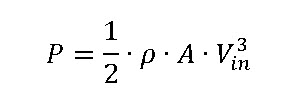Team:Valencia/Windmill
From 2010.igem.org
Time goes by...
(El tiempo pasa...)
Follow us:

Our main sponsors:

Our institutions:

Visitor location:
» Home » The Project » Creating Technologies » Microbial Albedo Recorder
Windmill
Theory
The power of the wind passing perpendicularly through a circular area is:
Where
- P is the power of the wind measured in W
- ρ is the density of air measured in kg/m3
- v is the velocity of the wind measured in m/s
- A is the analyzed area
The Betz’s Law demonstrate that the power that is possible to achieve from the wind is:
Therefore the power generated depends on the velocity of the wind passing through the turbine. It can be deduced that maximum power produced by a wind turbine is:
If we adapt this equation to our wind turbine, we need to add some parameters in order to study the interaction between the wind, our propellers and the motor.
Where r is the propeller´s length.
As you may see, power depends on wind speed and helix length
Construction
In our first attempts we tried to connect a small propeller directly to the motor. Unfortunately, the power produced was practically none because of the small size of the propeller. Remind that the power has a strong relation with the propeller length. Therefore, our next step was to increase the propeller size. With this modification we obtained a maximum power of 150mW.
After that, we deduced that the problem arose from the motor, which was not capable of generating enough power. This occurred because we used a DC current motor which works with maximum efficiency at high turn speed. Therefore, connecting the motor directly to the propeller the system was not reaching a high turn speed so the produced power was very low. Hence, the solution was adding a gearbox system able to multiply the turn speed on the motor shaft. This solution forced us to install a new propeller with a much wider area in order to get a higher starting torque.
Therefore:
We tried with different relations until we found the one that best suited our motor, which was 5:1.
Finally, we added a LED in order to facilitate the running of the system. The final power we generated with system was around 1.5W, which was more than enough to meet the energy demand coming from the Red House. "
"


